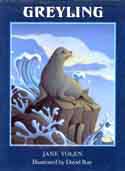
Greyling
Illustrated by William Stobbs (World edition)
Illustrated by David Ray (Philomel edition)
World publishing, 1968, Philomel 1968, 1991
ISBN# LC 68-28481 World hardcover (Stobbs)
ISBN#529-00542-5 Collins World hardcover (Stobbs)
ISBN#370-01504-5 William Collins World hardcover (Stobbs)
ISBN#0-399-22262-6 Philomel hardcover (Ray)
ISBN#0-590-46534-1 Scholastic paperback (Ray)
This is the story of a selchie, human on land and seal in the sea, who is adopted by a fisherman and his childless wife. They raise the boy, Greyling, and keep him from the sea, fearing that if he turned back into a seal he would never return. And then one fateful day, Greyling dives into the sea to save his father from a storm (see the plot for The Boy Who Had Wings!) I began the book one night while nursing my new baby, Heidi, thinking about the time she’d be old enough to leave home. Much of the story was written in my head and only got down on paper in the day during her nap times. English illustrator William Stobbs illustrations are strong and in the storytelling tradition of the time. Ray’s modern–even post modern–illustrations are more rounded, even plastic in feeling. The Ray illustrations were used as a basis for a short film which I narrated. There is a British edition of the Stobbs illustrated book, and an Afrikaans edition called “Grysling.” The Ray edition won the Ann Izard Storyteller’s Choice Award. The book has been a storyteller’s favorite since it first came out.
Accolades:
- Anne Izard Storyteller’s Choice Award 1992 (Rey edition)–“A lyrical retelling by a master storyteller of a selchie story that captures the haunting essence of an old Scottish tale.”
What reviewers have said:
- “The sound of the sea sweeps viewers into Jane Yolen’s tale of a selchie child… David Ray’s beautiful paintings complement it perfectly … with crisp three-dimensional waves and a rich palette of color. The haunting background music adds the final touch.”—School Library Journal.
- *Starred review* “Simple, limpid and grave story has the attributes of a traditional folk tale…lovely, rhythmic prose.” (Stobbs edition)—School Library Journal
- “The style has the gentle, crooning quality of the seal songs of the islands, and the rugged simplicity of the story is echoed by the dark bright paintings that so effectively picture the lonely grandeur of the region.” (Stobbs edition)—SR
- “An evocative tale, deceptive in its simplicity…The haunting background music adds the final touch to an exceptional viewing experience.”—SLJ review of Audio Visual package, read by JY
- “This bittersweet tale successfully blends magic, lore,and truth as it explores the theme that we must enjoy our children and then let them go.”—Booklist
- “Tender story with pictures that have a stark, poster-like quality that suits the rugged setting and a gracefulness of color and detail that suits the fantasy of the theme.” —(Stobbs edition) Bulletin of the Children’s Book Center
- “The author writes with the measured simplicity and figurative language of a folk tale…the full-color paintings which characterize the sturdy island people and picture the somber beauty of the turbulent water and the rugged, seagirt landscapes.” —(Stobbs edition) Horn Book